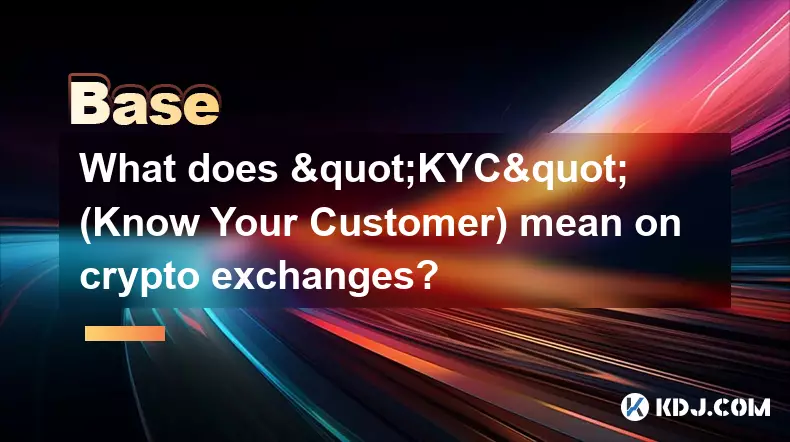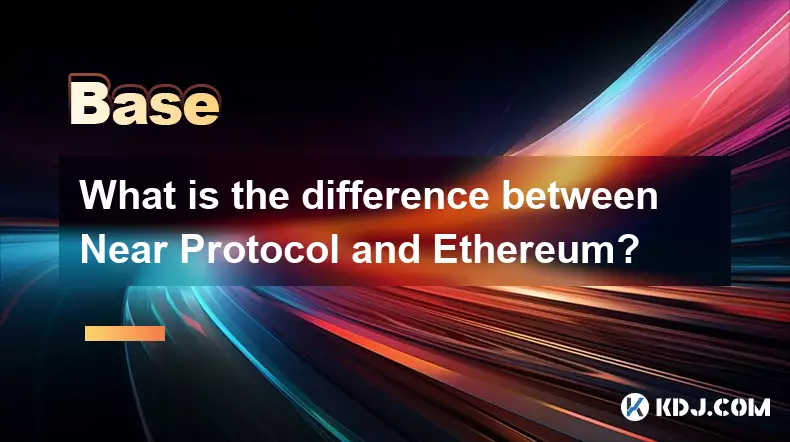-
 bitcoin
bitcoin $110918.433029 USD
-1.69% -
 ethereum
ethereum $3996.872473 USD
-2.43% -
 tether
tether $1.000594 USD
0.00% -
 bnb
bnb $1178.871834 USD
-2.38% -
 xrp
xrp $2.413973 USD
-3.47% -
 solana
solana $194.341461 USD
-4.24% -
 usd-coin
usd-coin $0.999963 USD
-0.03% -
 tron
tron $0.320092 USD
0.92% -
 dogecoin
dogecoin $0.196919 USD
-3.42% -
 cardano
cardano $0.669585 USD
-3.63% -
 hyperliquid
hyperliquid $37.485952 USD
-3.58% -
 ethena-usde
ethena-usde $1.000026 USD
-0.02% -
 chainlink
chainlink $18.018220 USD
-5.13% -
 bitcoin-cash
bitcoin-cash $523.879267 USD
-2.41% -
 stellar
stellar $0.324655 USD
-3.67%
What does "KYC" (Know Your Customer) mean on crypto exchanges?
KYC on crypto exchanges verifies user identity to prevent fraud and comply with regulations, but raises privacy concerns and limits access for some users.
Oct 14, 2025 at 01:01 pm

What Is KYC in the Context of Crypto Exchanges?
1. KYC, or Know Your Customer, refers to a mandatory verification process implemented by cryptocurrency exchanges to confirm the identity of their users. This procedure typically requires individuals to submit personal information such as government-issued identification, proof of address, and sometimes biometric data like facial recognition.
2. The primary goal of KYC is to prevent illegal activities including money laundering, terrorist financing, and fraud. By verifying user identities, exchanges can monitor transactions more effectively and comply with international financial regulations set by bodies such as the Financial Action Task Force (FATF).
3. Most centralized crypto platforms enforce KYC policies before allowing users to deposit, trade, or withdraw significant amounts of digital assets. The level of access often depends on the verification tier completed—basic accounts may have low limits, while fully verified users enjoy higher transaction caps and additional features.
4. While KYC enhances regulatory compliance and security, it has sparked debate within the crypto community. Critics argue that mandatory identity checks contradict the decentralized and privacy-focused ethos of blockchain technology, especially when compared to permissionless, non-custodial wallets and decentralized exchanges (DEXs) that do not require personal data.
How Do Exchanges Implement KYC Procedures?
1. Upon registration, users are prompted to provide documents such as passports, driver’s licenses, or national ID cards. These files are usually uploaded through secure portals integrated into the exchange’s website or mobile app.
2. Advanced verification systems employ artificial intelligence and machine learning to detect forged or altered documents. Some platforms also use liveness detection during video calls or selfie submissions to ensure the person submitting the ID is the actual owner.
3. Once submitted, the data undergoes automated and manual review processes. This step can take anywhere from minutes to several days depending on the exchange's workload and verification complexity.
4. After approval, user profiles are flagged as verified, enabling full platform functionality. Ongoing monitoring may occur, where unusual activity triggers re-verification requests or temporary account restrictions to maintain compliance.
The Impact of KYC on User Privacy and Access
1. One major concern surrounding KYC is the accumulation of sensitive personal data on centralized servers, which could become targets for cyberattacks or unauthorized surveillance. High-profile exchange breaches have demonstrated the risks associated with storing large volumes of identity information.
2. Users in regions with strict capital controls or oppressive regimes may avoid KYC-compliant platforms due to fear of government tracking or asset seizure. This has led to increased demand for anonymous trading options despite their limited liquidity and potential legal gray areas.
3. On the other hand, KYC facilitates institutional adoption of cryptocurrencies by providing a trusted framework for banks, hedge funds, and regulated financial entities to engage with digital assets without violating anti-money laundering (AML) laws.
4. Some exchanges offer hybrid models, allowing limited trading without KYC but requiring verification only when certain thresholds are crossed. This balances accessibility with regulatory obligations, though it still excludes users who refuse to disclose any personal details.
Frequently Asked Questions
What happens if I don’t complete KYC on a crypto exchange?You may be restricted from performing key actions such as withdrawing funds above a minimal limit, accessing advanced trading tools, or converting crypto to fiat currency. Some platforms allow basic trading but block higher-tier services until verification is complete.
Can I use a pseudonym or fake ID for KYC?No. Submitting false documentation is illegal and can result in permanent account suspension, loss of funds, and potential legal consequences. Verification systems cross-check IDs against official databases and flag inconsistencies automatically.
Are there reputable crypto exchanges that don’t require KYC?Yes, some decentralized exchanges (DEXs) like Uniswap or peer-to-peer platforms like HodlHodl operate without mandatory KYC. However, these often lack the convenience, speed, and customer support of centralized alternatives and may have lower trading volumes.
Is my KYC data shared with third parties?Reputable exchanges state in their privacy policies that they do not sell user data. However, they may share information with regulators, law enforcement agencies, or compliance partners when legally required. Always review an exchange’s data handling practices before uploading documents.
Disclaimer:info@kdj.com
The information provided is not trading advice. kdj.com does not assume any responsibility for any investments made based on the information provided in this article. Cryptocurrencies are highly volatile and it is highly recommended that you invest with caution after thorough research!
If you believe that the content used on this website infringes your copyright, please contact us immediately (info@kdj.com) and we will delete it promptly.
- Coinbase, BNB Token, and Fee Disputes: A New York Minute on Crypto's Latest Drama
- 2025-10-16 16:25:13
- B2B Payments Revolution: How API Integration and Virtual Cards are Changing the Game
- 2025-10-16 16:25:13
- Ethereum, Dogecoin, and the Market Rebound: What's the Hype?
- 2025-10-16 17:05:14
- Paxos, PYUSD, and Ethereum: A $300 Trillion Typo Heard 'Round the Crypto World
- 2025-10-16 16:45:12
- Pi Network, GCV, and Web3: Building a New Digital Reality
- 2025-10-16 16:45:12
- Bitcoin Rally: ETF Investors and Stephen Miran's Rate Cut Predictions
- 2025-10-16 16:50:01
Related knowledge

How do decentralized identity (DID) solutions work?
Oct 14,2025 at 11:36pm
Understanding Decentralized Identity in the Blockchain Ecosystem1. Decentralized identity (DID) solutions are built on blockchain networks, allowing i...

What is the difference between Near Protocol and Ethereum?
Oct 15,2025 at 08:01am
Near Protocol and Ethereum: Core Architectural Differences1. Near Protocol operates on a sharded blockchain architecture known as Nightshade, which al...

What does it mean for code to be "open source" in crypto?
Oct 12,2025 at 01:54pm
Understanding Open Source in the Cryptocurrency Ecosystem1. In the context of cryptocurrency, open source refers to software whose code is publicly ac...

What is the purpose of a "testnet"?
Oct 12,2025 at 09:01am
Understanding the Role of Testnets in Blockchain Development1. A testnet serves as a parallel version of a blockchain network, designed specifically f...

How to avoid phishing scams in crypto?
Oct 13,2025 at 06:18pm
Understanding Common Crypto Phishing Tactics1. Cybercriminals frequently use fake websites that mirror legitimate crypto exchanges or wallet platforms...

What is the difference between single-collateral and multi-collateral Dai?
Oct 12,2025 at 05:18pm
Understanding Single-Collateral Dai1. Single-Collateral Dai (SCD) was the original version of the Dai stablecoin launched by MakerDAO in 2017. It allo...

How do decentralized identity (DID) solutions work?
Oct 14,2025 at 11:36pm
Understanding Decentralized Identity in the Blockchain Ecosystem1. Decentralized identity (DID) solutions are built on blockchain networks, allowing i...

What is the difference between Near Protocol and Ethereum?
Oct 15,2025 at 08:01am
Near Protocol and Ethereum: Core Architectural Differences1. Near Protocol operates on a sharded blockchain architecture known as Nightshade, which al...

What does it mean for code to be "open source" in crypto?
Oct 12,2025 at 01:54pm
Understanding Open Source in the Cryptocurrency Ecosystem1. In the context of cryptocurrency, open source refers to software whose code is publicly ac...

What is the purpose of a "testnet"?
Oct 12,2025 at 09:01am
Understanding the Role of Testnets in Blockchain Development1. A testnet serves as a parallel version of a blockchain network, designed specifically f...

How to avoid phishing scams in crypto?
Oct 13,2025 at 06:18pm
Understanding Common Crypto Phishing Tactics1. Cybercriminals frequently use fake websites that mirror legitimate crypto exchanges or wallet platforms...

What is the difference between single-collateral and multi-collateral Dai?
Oct 12,2025 at 05:18pm
Understanding Single-Collateral Dai1. Single-Collateral Dai (SCD) was the original version of the Dai stablecoin launched by MakerDAO in 2017. It allo...
See all articles


























![Web3 Crypto Market Morning Report: The market is in decline, altcoins have fallen by more than 5%, Binance compensation has been received, and Memes on the Bnb chain have collectively plummeted [Vic TALK Issue 1444] Web3 Crypto Market Morning Report: The market is in decline, altcoins have fallen by more than 5%, Binance compensation has been received, and Memes on the Bnb chain have collectively plummeted [Vic TALK Issue 1444]](/uploads/2025/10/16/cryptocurrencies-news/videos/web-crypto-market-morning-report-market-decline-altcoins-fallen-binance-compensation-received-memes-bnb-chain-collectively-plummeted-vic-talk-issue/68f043c9c8b44_image_500_375.webp)















































